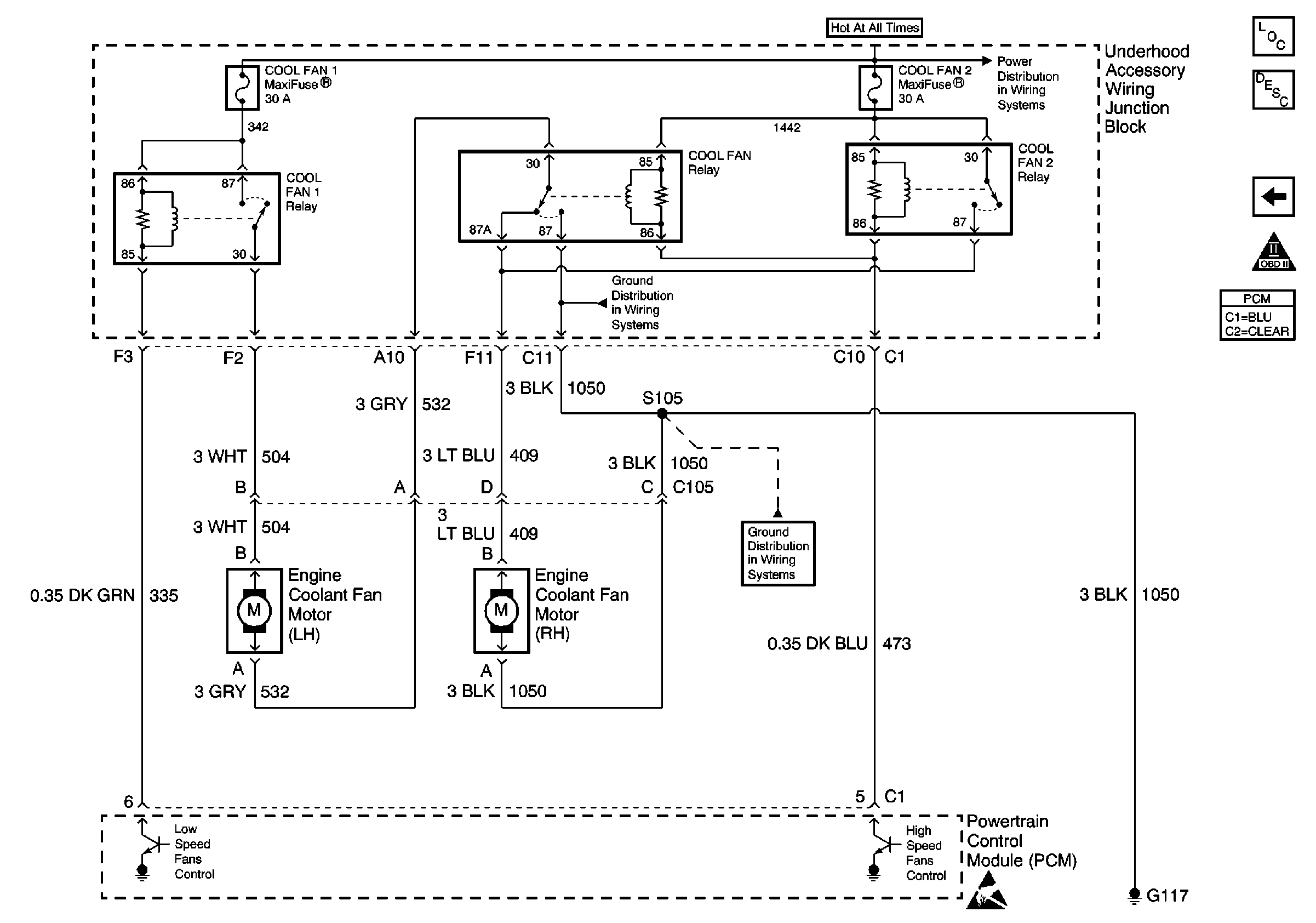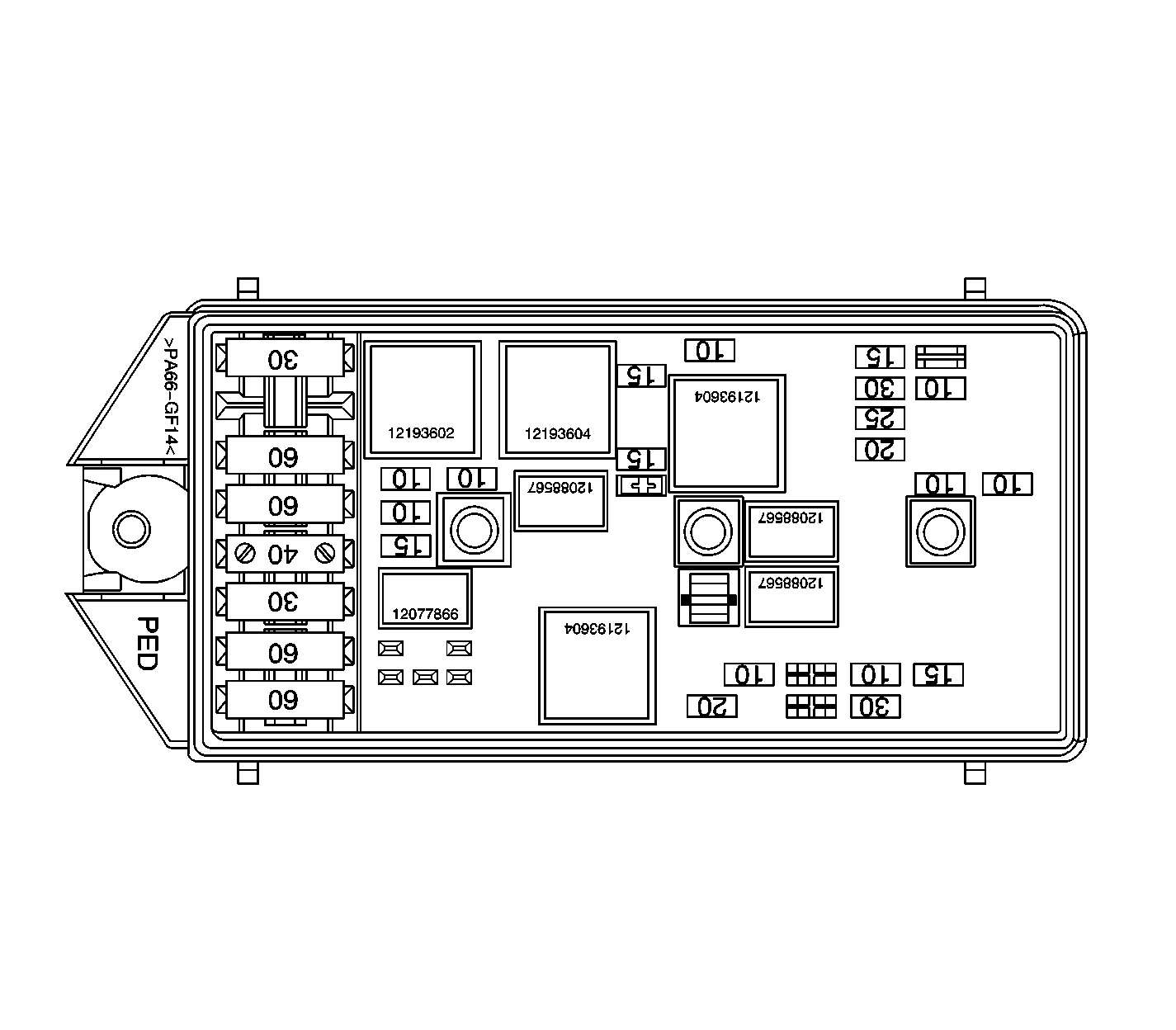Electric Cooling Fan Diagnosis Cooling Fan Functional Check
Refer to Engine Controls Schematic
Coolant Fan Motor #1 and Coolant Fan Motor #2

.
Circuit Description
The engine cooling fans receive power from two separate 30 amp MaxiFuses®
located in the
Underhood Accessory Wiring Junction Block -- Top View

.
Power for the fan motors is supplied through the
Underhood Accessory Wiring Junction Block -- Top View

.
The cooling fan relays are energized when current flows from the Cool Fan
1 MaxiFuse® and Cool Fan 2 MaxiFuse® in the
Underhood Accessory Wiring Junction Block -- Top View

through
the relay coils to ground through the PCM. The Low Speed Fans Control
circuit is grounded for low speed fans operation. The Low Speed Fans
Control circuit and the High Speed Fans Control circuits are all grounded
for high speed fans operation.
During low speed fans operation the PCM supplies a ground path for
the Cool Fan 1 Relay. This closes Cool Fan 1 Relay contacts, allowing current
to flow from the
Underhood Accessory Wiring Junction Block -- Top View

through the relay contacts
to the Engine Coolant Fan Motor LH (cooling fan #1 Motor). During low speed
operation, the ground path for the cooling fan #1 Motor is through
the Cool Fan Relay (series/parallel) and the Engine Coolant Fan Motor RH
(cooling fan #2 Motor). The result is a series circuit with both cooling
fans running at low speed.
During high speed cooling fan operation the PCM supplies a ground path
for the Cool Fan 1 Relay first through the Low Speed Fans control circuit.
After a 3 second delay, the PCM supplies a ground path for Cool Fan (series/parallel)
and Cool Fan 2 Relays through the High Speed Fans Control
circuit. This closes all three cooling fan relays. During high speed
fans operation, both the right and the left hand engine cooling fans
are supplied current from the MaxiFuses® in the
Underhood Accessory Wiring Junction Block -- Top View

and
each cooling fan has its own ground path.
The PCM will command Low Speed Cooling Fans operation under any of the following conditions:
Low Speed Cooling Fans Request
| • | When A/C is requested and ambient temperature is greater than 50°C (122°F). |
| • | When engine coolant temperature exceeds 106°C (223°F). |
| • | When A/C refrigerant pressure is greater than 190 psi (2 volts). |
| • | When the ignition is off and engine coolant temperature is greater than 140°C (284°F). |
Diagnostic Aids
Inspect for the following conditions:
If the owner complained of an overheating problem, determine if the complaint was due to an actual boil over, or the warning indicator illuminated, or the engine coolant temperature gauge indicated overheating. The gauge accuracy can also be checked by comparing the ECT Sensor reading using a scan tool and comparing its reading with the gauge reading. If the engine is actually overheating and the gauge indicated overheating, but the cooling fans are not turning on, the ECT sensor may have shifted out of calibration and should be replaced. If the engine is overheating and the cooling fans are on, the cooling system is suspect and should be inspected.
Important: : Remove any debris from the connector surfaces before servicing a component. Inspect the connector gaskets when diagnosing or replacing a component. Ensure that the gaskets are installed correctly. The gaskets prevent contaminate intrusion.
| • | Poor terminal connection. |
| Inspect the harness connectors for backed out terminals, improper mating, broken locks, improperly formed or damaged terminals, and faulty terminal to wire connection. Use a corresponding mating terminal to test for proper tension. Refer to Wiring Systems for diagnosis and repair. |
| • | Damaged harness. |
| Inspect the wiring harness for damage. If the harness inspection does not reveal a problem, observe the display on the scan tool while moving connectors and wiring harnesses related to the sensor. A change in the scan tool display may indicate the location of the fault. Refer to Wiring Systems for diagnosis and repair. |
| • | Inspect the PCM and the engine grounds for clean and secure connections. |
If the DTC is determined to be intermittent, reviewing the Failure Records can be useful in determining when the DTC was last set.
Test Description
The numbers below refer to numbers on the diagnostic table:
-
The PCM will enable the engine cooling fans when certain Diagnostic Trouble Codes are set. Go to applicable DTC Table first before proceeding with this table.
-
Allow engine coolant temperature to cool below 100°C (212°F) before proceeding with diagnosis.
Step | Action | Value(s) | Yes | No |
|---|---|---|---|---|
1 | Did you perform the Powertrain On Board Diagnostic (OBD) System Check? | -- | ||
Are any other DTCs set? | -- | |||
Are the cooling fans OFF? | 100°C (212°F) | Go to Electric Cooling Fan Diagnosis Electric Cooling Fan Table #1 | ||
4 | With a scan tool, command the low speed cooling fan relay ON. Do both cooling fans turn ON? | -- | Go to Electric Cooling Fan Diagnosis Electric Cooling Fan Table #2 | |
5 | With a scan tool, command the high speed cooling fan relay ON. Do both cooling fans switch to high speed? | -- | Go to Electric Cooling Fan Diagnosis Electric Cooling Fan Table #3 | |
6 |
Are the cooling fans ON? | -- | ||
7 | Turn ON the A/C. Are the cooling fans ON? | -- | System OK | |
8 | Does the scan tool display A/C request as YES? | -- | Go to Diagnostic System Check in HVAC Systems -- Manual OR Diagnostic System Check In HVAC Systems -- Automatic | |
9 |
Important: : Program the replacement PCM. Replace the PCM. Refer to Powertrain Control Module Replacement/Programming . Did you complete the replacement? | -- | System OK | -- |
Electric Cooling Fan Diagnosis Cooling Fan Table #1
Step | Action | Value(s) | Yes | No |
|---|---|---|---|---|
1 | Did you perform the Electric Cooling Fan Functional Check? | -- | Go to Electric Cooling Fan Diagnosis Electric Cooling Fan Functional Check | |
2 |
Are both fans OFF? | -- | ||
3 | Disconnect the Cool Fan (Series/Parallel or S/P) Relay. Are both fans OFF? | -- | ||
4 | Remove the Cool Fan 2 Relay. Are both fans OFF? | -- | ||
5 |
Does the test lamp illuminate? | -- | ||
6 | Probe the Cool Fan S/P Relay switch feed terminal at the right fan connector using a test lamp that is connected to ground. Does the test lamp illuminate? | -- | ||
7 | Probe the High Speed Fans control circuit at the Cool Fan S/P Relay connector using a test lamp that is connected to battery positive voltage. Does the test lamp illuminate? | -- | ||
8 |
Is the test lamp still illuminated? | -- | ||
9 | Probe the Low Speed Fans control circuit at the Cool Fan 1 Relay connector using a test lamp that is connected to battery positive voltage. Does the test lamp illuminate? | -- | ||
10 |
Is the test lamp still illuminated? | -- | ||
11 | Test the right fan feed circuit for a short to voltage and repair as necessary. Refer to Wiring Repairs in Wiring System. Did you find and correct a condition? | -- | Go to Electric Cooling Fan Diagnosis Electric Cooling Fan Functional Check | |
12 | Test the left fan feed circuit for a short to voltage and repair as necessary. Refer to Wiring Repairs in Wiring System. Did you complete the repair? | -- | Go to Electric Cooling Fan Diagnosis Electric Cooling Fan Functional Check | -- |
13 | Repair the short to voltage in
the Cool Fan S/P Relay switch feed circuit. Refer to
Wiring Repairs
in Wiring System. The short may be in the
Did you complete the repair? | -- | Go to Electric Cooling Fan Diagnosis Electric Cooling Fan Functional Check | -- |
14 | Replace the Cool Fan 1 Relay. Did you complete the replacement? | -- | Go to Electric Cooling Fan Diagnosis Electric Cooling Fan Functional Check | -- |
15 | Test
the High Speed Fans control circuit or the Low Speed Fans control circuit
for a short to ground and repair as necessary. Refer to
Wiring Repairs
in Wiring System. The short may
be in the
Did you complete the repair? | -- | Go to Electric Cooling Fan Diagnosis Electric Cooling Fan Functional Check | -- |
16 | Replace the Cool Fan 2 Relay. Did you complete the replacement? | -- | Go to Electric Cooling Fan Diagnosis Electric Cooling Fan Functional Check | -- |
17 | Replace the Cool Fan S/P Relay. Did you complete the replacement? | -- | Go to Electric Cooling Fan Diagnosis Electric Cooling Fan Functional Check | -- |
18 |
Important: : Program the replacement PCM. Replace the PCM. Refer to Powertrain Control Module Replacement/Programming . Did you complete the replacement? | -- | Go to Electric Cooling Fan Diagnosis Electric Cooling Fan Functional Check | -- |
